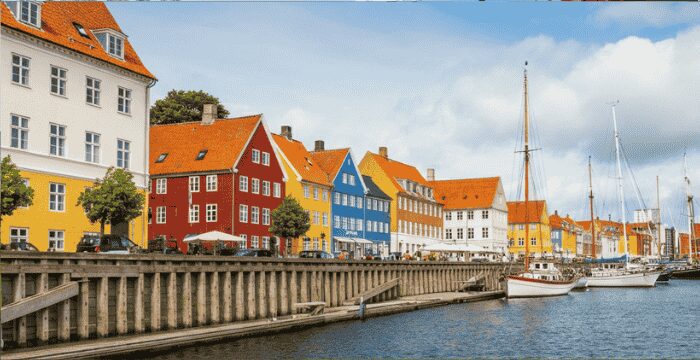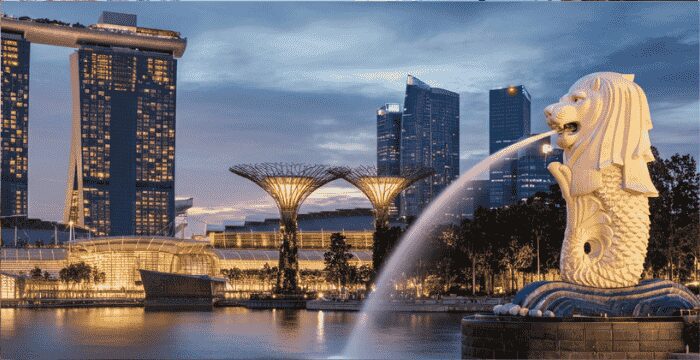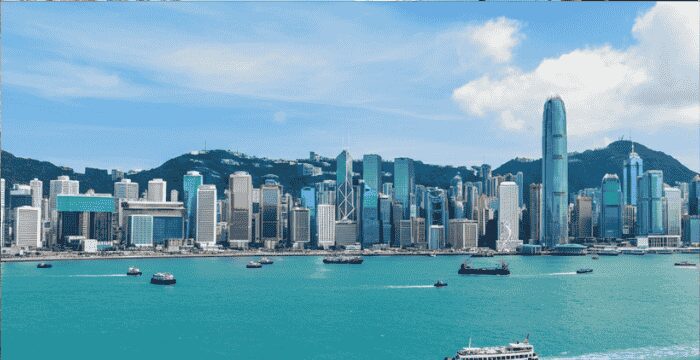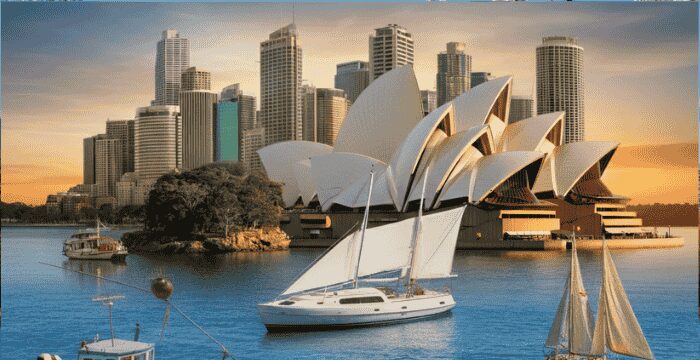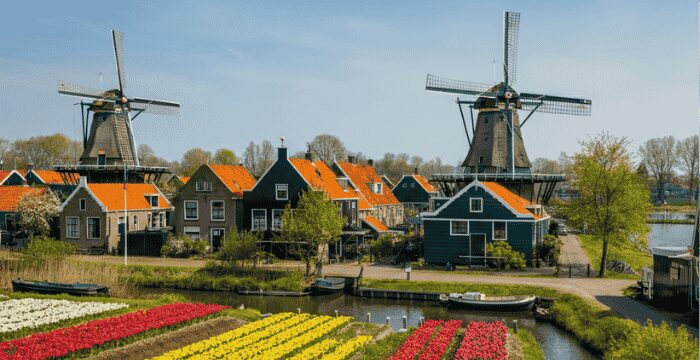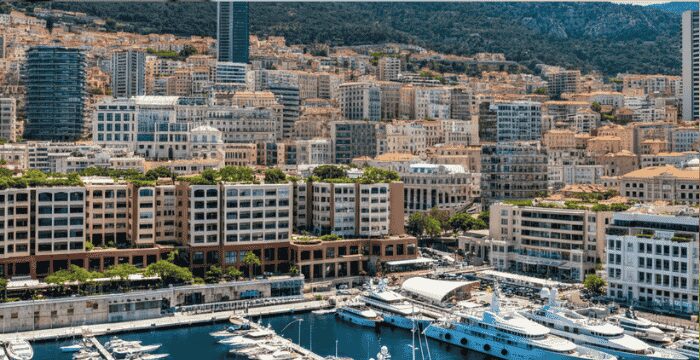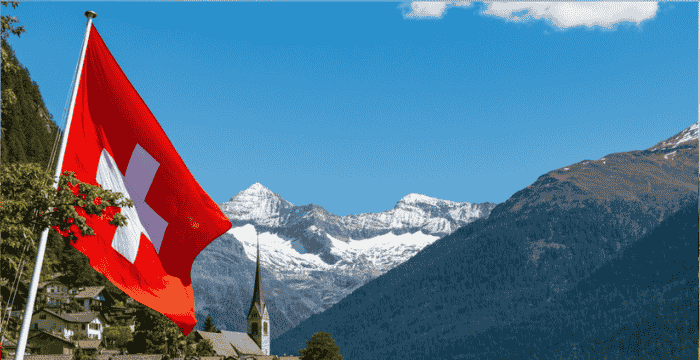The most expensive country in the world continues to be Monaco, where residents face living costs that are 3.88 times higher than the global average. In our journey in the year 2025, the cost of living around the world is at an all-time high, and some countries have attained phenomenal prices on simple necessities and general cost of living expenditures.
New changes have transformed the arena of high-cost destinations across the globe. The cost of living in Switzerland has risen sharply by 15 per cent in leading cities such as Zurich and Geneva during the year 2025. Singapore’s housing market has experienced a dramatic 22% year-over-year increase, solidifying its position among the top 10 most expensive countries in the world. In the meantime, the inflation rate in Iceland has levelled off but the cost of importing goods keeps the living expenses high.
The Cayman Islands has emerged as the second most expensive country in the world to live in, with monthly costs reaching $3,374 per person. The high living standards system in Norway is one of the reasons why the country has one of the highest living costs, and the fact that the country has recovered well after the pandemic has led to increased costs in the country, as well as other conventional high-cost destinations around the world.
These dramatic shifts in global living standards reflect broader economic changes, currency fluctuations, and evolving quality of life rankings that continue to reshape where people choose to live and work internationally.
Latest List of Most Expensive Countries in the World 2025
Here is the latest list of the top 10 most expensive countries in the world:
- Monaco
- Cayman Islands
- Singapore
- Switzerland
- Iceland
- Ireland
- United States
- Liechtenstein
- Bahamas
- Australia
Top 10 Most Expensive Countries in The World 2025
The top 10 most expensive countries in the world represent diverse geographic regions and economic models, yet all share common characteristics that drive elevated living costs. These countries regularly top various cost of living indices, indicating a prolonged tendency towards high cost of living.
The latest rankings have Monaco as the most expensive with monthly expenses of $6,538, Cayman Islands as the second most expensive with $3,374, and Singapore at number three with 3,000. Switzerland remains at the top at $2,896 per month, and Iceland completes the top five at $2,518. These are the total living costs covering house, food, transport, and other necessities.
Economic indicators across these countries reveal strong currencies, high GDP per capita, and robust economic stability. Nevertheless, the correlation between income and expenses differs greatly, as some countries have high wages that balance out the high cost of living, and some make it difficult to afford even for high-income citizens.
| Rank | Country | Monthly Cost (USD) | Cost of Living Index | Purchasing Power Index | Key Drivers |
| 1 | Monaco | $6,538 | 94.8 | 72.3 | Tax haven, luxury market |
| 2 | Cayman Islands | $3,374 | 94.8 | 58.4 | Import costs, tourism |
| 3 | Singapore | $3,000 | 77.1 | 93.8 | Housing, urban density |
| 4 | Switzerland | $2,896 | 84.0 | 159.7 | Strong currency, quality |
| 5 | Iceland | $2,518 | 64.5 | 123.5 | Import reliance, isolation |
| 6 | Ireland | $2,438 | 57.4 | 108.9 | Housing shortage, growth |
| 7 | United States | $2,433 | 59.5 | 146.2 | Urban living costs, healthcare |
| 8 | Liechtenstein | $2,315 | N/A | N/A | Limited space, affluence |
| 9 | Bahamas | $2,295 | 66.3 | 58.4 | Tourism, import dependency |
| 10 | Australia | $2,293 | 55.6 | 135.4 | Housing, geographic isolation |
Switzerland
Switzerland is one of the most expensive countries almost every time because of its strong currency, the Swiss Franc, and quality of life. One-bedroom apartments in Zurich rent at an average of over $2,800 per month, and average incomes of about $85,000 per year allow the citizens to afford such prices. The country’s purchasing power parity remains favorable, with residents able to afford high-quality goods and services despite elevated prices.
Norway
Norway maintains expensive urban living costs, particularly in Oslo, where housing affordability challenges persist with price-to-income ratios of 7.8. The country’s comprehensive social benefits and public services justify costs for many residents, while strong wages and economic stability support high purchasing power parity.
Iceland
Iceland deals with high costs because of its isolated territory and shortage of housing. The cost of living index reflects significantly higher rent and grocery costs compared to European averages. Nevertheless, in spite of these difficulties, Iceland has outstanding healthcare and education, which explains the attraction of expats who are ready to pay high prices in order to have a high quality of life.
Denmark
Denmark is characterized by high living standards and a strong welfare state. Copenhagen’s tight housing market drives up prices and rent, while the cost of living index reflects expensive food and transportation. The taxes are used to finance good-quality public services, and competitive salaries are used to subsidize high costs.
Singapore
Singapore represents a luxury lifestyle destination with substantial urban living costs, especially in housing. The housing price-to-income ratio reaches 18.7, indicating significant housing affordability challenges. Nevertheless, Singapore has good infrastructure, security, and access to business worldwide, making it a destination for expatriates and multinational businesses despite the high expenses.
Luxembourg
Luxembourg is characterized by high wages and economic excellence; however, the living expenses are quite high, especially the cost of accommodation. The country ranks highly in global salary comparison, helping residents manage expensive lifestyles. The presence of small size and high housing demand leads to the perpetuation of the affordability problems.
Hongkong
Hong Kong offers one of the most unfriendly housing markets in the world, as the price-to-income ratios have hit the 30 mark. Small space and crowded cities drive rent and property prices to remarkable highs. Irrespective of these expenditures, Hong Kong is a significant financial center with competitive wages and lively lifestyle prospects.
Australia
Australia has a high standard in its capital cities, such as Sydney and Melbourne, which is pushed by housing prices and city costs. The country provides good salaries and quality healthcare, but housing affordability concerns persist for many residents. The cost of living index reflects these urban challenges across major metropolitan areas.
Sweden
Sweden offers high living standards with relatively balanced housing affordability compared to other Nordic countries. Life prices are high, although social welfare and state services offer nets. Urban living costs in Stockholm are significant but manageable with competitive salary levels.
Netherlands
The Netherlands combines high living costs with strong economic indicators. The competitive housing market in Amsterdam contributes to high rent and property prices, and good salaries, as well as public services, ensure its popularity among expats despite high costs.
Understanding What Makes a Country Expensive: Experts’ Insights 2025
Understanding what drives a nation to become the most expensive country in the world requires examining multiple interconnected factors that influence daily living costs. The cost of living index serves as the primary measurement tool, evaluating expenses across housing, transportation, food, healthcare, and other essential services.
There are a few basic factors that make living in some countries so darn expensive. Economic indicators like GDP per capita, currency strength, and inflation rates directly impact pricing structures. Strong economies usually push prices up because there is a greater demand for goods and services, a low supply, and the purchasing power of the people is also high.
Geographical elements are equally important. Island countries and landlocked countries that have few natural resources usually have higher costs of importation, which is reflected in the consumer as high prices. Urban living costs in major metropolitan areas further amplify expenses due to concentrated demand and limited space availability.
Latest Key Factors Determining Living Costs Abroad 2025
- The biggest part of the living costs in high-priced nations is represented by housing and real estate prices. The scarcity of land, stringent zoning laws, and the demand by residents and investors push the prices of property to the sky. A 900-square-foot apartment in Monaco may rent in the amount of $4,058 per month.
- Transportation and fuel expenses differ largely depending on the development of infrastructure, tax on fuel, and mass transport. The individual transport expenses can be subsidized in countries having an elaborate mass transit system, and the fuel and maintenance costs are higher in countries where people rely on personal cars.
- The costs of food and groceries are indicative of import capacities or agricultural efficiency, and domestic market conditions. Island states and those states that have severe weather conditions tend to be highly dependent on imported foodstuffs, leading to high margins charged to customers.
- Health and insurance expenses vary tremendously between countries that have universal healthcare systems and those that have privatized medical care. Countries that have universal care coverage can spread the cost via taxation, whereas the others force people to incur direct healthcare costs.
- The taxation systems have great effects on the net income and the purchasing power. High-tax nations can justify this by providing better public services, whereas low-tax economies can force people to make direct payments to access services that are otherwise offered by governments.
- Dependency on imports makes them susceptible to the international supply chain as well as currency changes. The nations that manufacture few products locally are more vulnerable to any international shipping costs and tariffs, or unfavorable exchange rates that are unfavorable.
- Latest Cost of Living Measurement Indices 2025
The Numbeo Cost of Living Index provides comprehensive data comparing living expenses across countries and cities worldwide. This index has NYC as the base (100), and thus, direct comparisons can be made between locations. Its methodology takes into account housing, food, transportation, and other basic costs to generate standardized rankings.
An alternative view is provided by World Bank data on purchasing power that converts the costs according to the local income and the currency rate. It is a method of seeing the real affordability instead of fixed costs, which can give an idea of how much money can go in various places.
Local purchasing power indices bring together cost indices and average wages to establish what is actually affordable. A nation may be expensive in absolute terms, but may also have proportionately high wages, so the actual standards of living are higher than the bare cost indicators would imply.
| Index Type | Primary Focus | Baseline | Key Advantage |
| Numbeo Cost of Living | Absolute costs | New York = 100 | Global standardization |
| World Bank PPP | Currency-adjusted costs | USD baseline | Economic accuracy |
| Local Purchasing Power | Income vs. costs | Local wages | Real affordability |
| Quality of Life Index | Comprehensive living | Multiple factors | Holistic view |
| Rent Index | Housing costs only | New York = 100 | Housing focus |
Monaco: The Most Expensive Country in The World in 2025
Monaco stands as the undisputed most expensive country in the world, with monthly living costs averaging $6,538 for individuals. The unusual costs of this Mediterranean microstate are caused by the unique characteristics of this state: the lack of space, the high level of luxury, and tax benefits that make this state the home of the wealthiest people in the world.
The status of the principality as a tax haven also makes the residency artificially demanded, which increases all expenditures related to residing in the principality. Having no personal income tax on residents, Monaco becomes home to high-net-worth individuals who are ready to afford high prices on housing and services to save huge amounts of taxes.
Monaco’s luxury lifestyle destination status means that virtually all services cater to an affluent clientele. Whether it is restaurants or retail shops, the pricing of goods and services is aligned with the purchasing power of the rich clientele, and as such, it has resulted in a world where even commodities have high prices.
Monaco Living Cost Breakdown in 2025: Experts Update
The monthly costs per person in Monaco come to $6,538, which is considerably higher than in any other country12. Housing is the biggest cost item, where a one-bedroom apartment in the city center would be EUR 4,000- EUR 7,000 per month, and bigger apartments are more than EUR 10,000 per month.
The high prices and the dynamics of the real estate market indicate the acute shortage of space in Monaco. Its land area is a meager 2.02 square kilometers, making each square meter of land extraordinarily prices. With property rates of up to $74,483 per square meter in the city center areas10, the real estate in Monaco is one of the most expensive in the world.
The opulent lifestyle and exclusive facilities are a part of everyday life. Simple restaurant dishes are priced at EUR 25- EUR 50, and three-course meals in medium restaurants are more than EUR 1002. Even basic things like grocery shopping are costly, with prices being 10-30% more expensive than in nearby France.
| Expense Category | Monthly Cost (USD) | Annual Cost (USD) | Percentage of Total |
| Housing (1-bedroom) | $5,775 | $69,300 | 88% |
| Food & Dining | $735 | $8,820 | 11% |
| Transportation | $59 | $708 | 1% |
| Utilities | $175 | $2,100 | 3% |
| Total Living Cost | $6,744 | $80,928 | 100% |
Why is Monaco the Most Expensive Country in the World in 2025?
The lack of land area forms the basis of scarcity that dictates high prices in Monaco. Its high population density of less than 40,000 people sprawled over 2.02 square kilometers means that space is highly expensive, whether as residential or commercial real estate. This geographic limitation implies that the supply cannot be increased to match the demand, and it keeps all costs under upward pressure.
The status of a tax haven with many wealthy residents causes an artificial increase in the demand for Monaco residency. People who save millions of dollars in taxes can afford to pay unprecedented prices on housing and services, and this makes the market where the usual economic rules no longer work. The wealth of the average resident is much higher than the world standards, which justifies the businesses charging on these grounds.
High-end services and luxury tourism round off the expensive ecosystem in Monaco. The image of the principality draws tourists who are ready to pay high prices and expect luxury services, which motivates companies to adhere to the principles of luxury. This type of tourism helps to strengthen the model of Monaco as a place where everything is more expensive, yet provides outstanding quality and uniqueness.
Latest Detailed Profiles of the Most Expensive Countries in the World 2025
To determine why some countries are always among the most expensive countries in the world, one has to look at the economic, geographic, and social peculiarities of these countries. All these high-cost locations have their own reasons that contribute to high costs and usually give equal reasons in the form of advantages to the locals that make such costs worth it to them.
Quality of life rankings often correlate strongly with high living costs, as expensive countries typically invest heavily in infrastructure, healthcare, education, and public services. Such correlation forms a complicated interdependence in which increased costs can correspond to improved living standards, more opportunities, and increased safety of inhabitants.
The currency exchange impact plays a crucial role in determining relative costs for international visitors and expatriates. These destinations can be very expensive to foreigners, especially when they have strong currencies such as the Swiss Franc, Norwegian Krone, and Singapore Dollar, and may offer higher purchasing power to their residents when they travel abroad.
Most Expensive Countries in the World: Comparison of Costs in the Region Analysis 2025
Global rankings are dominated by European high-cost destinations, with Switzerland, Norway, Iceland, and Denmark setting the pace on the continent. These countries are characterized by some common features, such as good social welfare programs, heavy taxation, and their economies are very sound and able to sustain high standards of living. Economic integration within the European Union has brought about comparatively stable currencies and trade relations that ensure cost structures are maintained.
The high-cost countries in the Asia-Pacific region have a different profile, as Singapore and Hong Kong are very densely populated urban centers where the lack of space makes costs high. The geographic isolation of Australia adds to importation costs, and the high economy and land shortage in Japan add to the high costs. High costs are often compensated for by these countries with better infrastructure and business opportunities.
North American expensive areas differ greatly within nations, with big urban communities, such as New York, San Francisco, and Toronto, charging top prices. The United States is especially complicated, as the costs of healthcare and regional differences make the patterns of expenses in the various states and cities different.
The Caribbean high-priced islands encounter special issues associated with importation reliance and a tourism-based economy. The inability to produce many goods locally would force the island to import most of its products, making it susceptible to the price of shipping and supply chain issues. Tourism demand may lead to overinflated prices for both the visitor and the resident of these destinations.
| Region | Average Monthly Cost | Primary Cost Drivers | Quality of Life Score |
| Western Europe | $2,400 | Social services, strong currencies | 8.5/10 |
| Asia-Pacific | $2,200 | Urban density, import costs | 8.2/10 |
| North America | $2,100 | Healthcare, housing markets | 8.0/10 |
| Caribbean | $1,800 | Import dependency, tourism | 7.5/10 |
| Middle East | $1,600 | Energy costs, luxury markets | 7.8/10 |
Switzerland: Europe’s Most Expensive Country to Live in 2025
Switzerland maintains its position as Europe’s most expensive country in which to live, with comprehensive costs reflecting the nation’s exceptional quality of life and economic stability. The high Swiss Franc, high wages, and excellent public services make the country such that high costs tend to reflect into matching high living standards.
Living expense calculator data shows Switzerland requiring approximately CHF 4,500-5,500 monthly income for comfortable living, depending on the city. The average after-tax salary is approximately €5,500 per month, which guarantees a good life even in the face of high expenses. The country’s purchasing power parity remains favorable, with residents able to afford quality goods and services.
The status of Switzerland as an international finance, science, and technology hub means that the country is able to attract international talent that is ready and willing to shell out top dollars to gain career experience and quality of life privileges. Political stability, a low crime rate, and an excellent healthcare system explain the high costs to many residents and expats.
Latest Swiss Cities Cost Breakdown in 2025
The living expenses in Zurich and Geneva are the most expensive in Switzerland, as both cities are among the most expensive cities in the world. One-bedroom apartments in Zurich rent at above CHF 2,800 per month, and Geneva asks the same rent because of the presence of international organizations and the shortage of housing stock.
Analysis of the housing market shows that the price of real estate in Switzerland indicates the scarcity of land and a strict zoning policy. The rise in property value in prime cities has been on an upward trend due to foreign demand and local population growth. The restrictions on foreign investment have been useful in smoothing out some of the price pressures, but have not stopped the major appreciation.
The transportation and everyday expenses in the Swiss cities enjoy the advantage of very good public transport systems that limit the necessity of individual vehicles. Monthly transport tickets are about CHF 90 and allow unlimited travel by train, bus, and tram. Food, entertainment, and service costs are high in Switzerland on a daily basis.
| Swiss City | Monthly Rent (1BR) | Transportation Pass | Grocery Budget | Total Monthly Cost |
| Zurich | CHF 2,800 | CHF 90 | CHF 600 | CHF 4,200 |
| Geneva | CHF 2,700 | CHF 85 | CHF 580 | CHF 4,100 |
| Basel | CHF 2,200 | CHF 75 | CHF 520 | CHF 3,500 |
| Lausanne | CHF 2,000 | CHF 70 | CHF 500 | CHF 3,200 |
| Bern | CHF 1,800 | CHF 65 | CHF 480 | CHF 3,000 |
Swiss Quality of Life vs. Cost Balance in 2025: Updated
Expenses compensated by high salaries can be considered an important factor making Switzerland livable despite high costs. Average salaries of about CHF 80,000 per year are already an excellent source of purchasing power, and specialized expertise in finance, technology, and pharmaceuticals can easily earn much more. This salary is able to assist the residents in living in Switzerland with its high-quality yet expensive lifestyle.
Several costs are justified by healthcare and education benefits that offer high-quality service and wide coverage. The healthcare system of Switzerland is one of the finest in the world, and education standards at both primary and tertiary levels are equally high. These government services are paid for by taxes and insurance systems, and their value compensates for direct expenses.
The infrastructure and safety standards result in environments where people have access to reliable public services, efficient transport systems, and outstanding personal safety. Whether it is mountain railways or the urban transit systems, the investment in infrastructure has brought convenience and quality to the people of Switzerland, which many are willing to pay the premium prices.
Singapore: Asia’s Most Expensive Country in The World to Live in 2025
Singapore stands as Asia’s most expensive country in the world to live, with monthly costs averaging $3,000 and housing expenses that have surged 22% year-over-year in 202514. The peculiar status of the city-state as an international financial center and a luxury resort contributes to the situation when the shortage of space and the demand from abroad push the living costs off the scale.
Expat living costs in Singapore present particular challenges, with housing representing the largest expense category. The price-to-income ratio of housing is as high as 18.7, which means that even high-income professionals have severe problems with affordability. Nonetheless, the strategic location, business, and lifestyle in Singapore still attract international talent in spite of these expenses.
Tax implications in Singapore prove more favorable than many expensive destinations, with competitive corporate and personal tax rates that help offset high living costs. Due to the efforts of the government to attract foreign business and talent, the government has developed a set of policies that allow expatriate populations to thrive in the country, as well as ensuring that the standard of services provided remains high.
The Singapore Housing Market Reality: Experts’ Insights 2025
The HDB and non-subsidised housing cost residents dramatically different price points. Housing Development Board (HDB) flats, which can be offered to citizens and permanent residents, are more affordable but have high prices as well. In April 2025, 141 HDB resale flats changed hands at S$1 million and above, constituting 6.1 per cent of the total number of resales.
The expatriate rental market is concentrated on private housing, which may cost more than S$4,000 per month, even for modest housing. Estates such as Queenstown, Toa Payoh, and Bukit Merah are mature and have high prices because of their location near MRT lines and other established amenities. Recently, a five-room unit in Toa Payoh was transacted at S$1.49 million, a new estate record.
The consideration of property investment indicates a lack of land and the growing population in Singapore. The policies set by the government, such as the Additional Buyer Stamp Duty (ABSD) and the loan-to-value limit, seek to smooth out the rising prices without destabilizing the market. There are extra restrictions on foreign investors and an increase in tax rates.
| Housing Type | Average Monthly Cost | Target Residents | Key Features |
| HDB 3-room | S$2,500-3,500 | Citizens, PRs | Government subsidies |
| HDB 4-room | S$3,500-4,500 | Citizens, PRs | Family-sized units |
| Private Condo | S$4,000-8,000 | All residents | Premium amenities |
| Landed Property | S$8,000-15,000+ | High-income residents | Private space |
| Serviced Apartment | S$5,000-12,000 | Expat living costs | Furnished, flexible |
Latest Daily Living Expenses in Singapore 2025
The pricing in the food court vs. the restaurant provides huge differences in the prices of food. Meals in local hawker centers cost S$3-8, whereas mid-range restaurants have prices ranging between S$25-50 per person. Fine dining may cost more than S$100 per head, showing that Singapore is a luxury lifestyle city, with international standards of culinary arts.
Mass transport fares are on the lower side, even though the general cost of living is high. The monthly transport passes are about S$120, which allows unlimited travel on MRT trains, buses, and LRT systems. The extensive public transport system means that ownership of a private vehicle is unnecessary, although it is highly costly to own a car because of the Certificate of Entitlement (COE) regulations.
The costs of healthcare and insurance differ greatly between the public and private ones. The healthcare system in Singapore offers quality services by both sectors, whereby the government subsidizes healthcare services to its citizens and permanent residents. International insurance and Private healthcare may cost S$200-500 per month with comprehensive cover.
List of the Most Expensive Countries in The World by Region in 2025
The list of the most expensive countries in the world varies significantly by geographic region, reflecting local economic conditions, resource availability, and development levels. The knowledge of the regional patterns can assist in finding alternatives, as well as how some areas are always more expensive to live in compared to others.
Regional breakdown shows that economies that are developed, have strong currencies, extensive social service programs, and have minimal natural resources are also the ones that rank high in global expense charts. Currency exchange impact plays a crucial role, as strong local currencies can make destinations particularly expensive for international visitors while potentially providing residents with greater purchasing power abroad.
Global living standards correlate strongly with expense levels, as countries investing heavily in infrastructure, healthcare, education, and public services typically require higher costs to maintain these systems. This relationship creates complex decisions for individuals considering relocation costs to expensive destinations.
Most Expensive European Countries in 2025: The Latest Updated List
European expense rankings are dominated by Switzerland, Norway, Iceland, and Denmark, which have common features of good social welfare systems, high taxation, and good economies. These Nordic and Alpine countries are habitually among the most expensive places in the world, and yet they offer an outstanding quality of life and government services.
Comparison of cost with EU averages. These high-cost countries are demanding 150-200 percent more than the European Union medians. There are premium prices when it comes to housing, food, and service, but normally, salaries are higher to compensate. The European single market has brought about a relatively stable cost structure within the member countries.
The effect of Brexit on UK expenses has added more complications to British living expenses, as the currency fluctuation and the change in trade relationships influence the cost of imports and the general price level. UK remains high priced, especially in London and Southeast England, but it is no longer among the very top of the world.
| European Country | Monthly Cost (USD) | EU Average Comparison | Primary Cost Drivers |
| Switzerland | $2,896 | +180% | Currency, wages, quality |
| Norway | $1,924 | +145% | Oil wealth, social services |
| Iceland | $2,518 | +165% | Import dependency, isolation |
| Denmark | $1,923 | +144% | Taxation, welfare system |
| Ireland | $2,438 | +158% | Housing shortage, growth |
| Luxembourg | $2,200 | +142% | Financial sector, small size |
Costliest Asia-Pacific Nations in 2025
Singapore, Hong Kong, Australia, and Japan are examples of various economic paradigms in the Asia-Pacific region, but have one thing in common: the high costs of living that can be explained by geographic factors, city density, or import reliance. Such countries usually subsidize the expensive rates with excellent infrastructure and business prospects.
Economic reasons causing high expenses are scarce land area in city-states such as Singapore and Hong Kong, geographic seclusion, which influences the cost of imports in Australia, and a well-developed economy in Japan, which sets high standards of services and wages. These countries can be especially costly to foreign travelers because of their currency strength.
Asia-Pacific destination cities that are expensive but expat-friendly usually have extensive expatriate support structures, such as helping with housing, international schools, and access to healthcare. Such services are provided at a premium price but facilitate transition issues faced by moved families and professionals.
High-Cost North American Destinations in 2025
The regional differences within the United States make it abundant in dramatic discrepancies in costs amongst high-priced coastal urban centers and the relatively lower-priced inland regions. New York, San Francisco, and Los Angeles are some of the most expensive cities in the world, whereas Midwestern and Southern cities have much cheaper living costs.
Canada’s expensive cities, including Vancouver and Toronto, face particular challenges with housing affordability, driven by international investment and limited supply. The Canadian dollar is strong, and social services are extensive, which contributes to high costs, but universal healthcare eliminates certain areas of expenses in comparison to the United States.
The North American cost of living trends have exhibited a further rise in the big metros, which has been fueled by the growth in technology sectors, home shortage, and infrastructure pressures. The trends towards remote working will potentially moderate certain cost pressures, as there will be less pressure to be in the city center, which is expensive.
Latest Cost of Living Comparison: Most Expensive vs. Affordable Countries in 2025
Comparing the most expensive countries in the world with affordable destinations reveals dramatic differences in daily living costs, purchasing power parity, and quality of life rankings. These comparisons assist in demonstrating the cost-benefit analysis of lifestyle and cost aspects that inform international moving.
International cost comparison data shows that residents of expensive countries often pay 300-400% more for basic necessities compared to affordable destinations. But, the salary rates, government services, and quality of infrastructure may be proportional, which makes complicated calculations of the real value and affordability.
Global salary comparison reveals that high-cost countries typically offer correspondingly elevated wages, though the relationship isn’t always proportional. There are high-cost locations that offer greater buying power than absolute cost, and there are high-cost locations that pose a challenge even to the well-paid locals.
Purchasing Power Analysis: Experts’ Insights 2025
Ratios of salary to cost of living give important information on real affordability, not just sheer cost. Although Switzerland is one of the most costly nations, its purchasing power is favourable considering average wages of CHF 80,000 can sustain monthly expenses of CHF 4,5003. Such a 2.3-month coverage ratio is a good sign of affordability by residents.
The cost comparison should include quality of life modifications because in high-cost countries, the quality of medical care, education, infrastructure, and safety services is usually better and warrants the extra costs. These advantages are not reflected in simple cost-benefit analysis but are an important factor in the real-life experiences of residents and long-term financial stability.
Economic indicators comparison shows that expensive countries typically maintain stable currencies, low inflation rates, and robust economic growth that support high living standards. Such considerations offer security and predictability, which can offset any increase in daily costs with decreased financial risk and improved long-term opportunities.
| Country Category | Monthly Cost | Average Salary | Coverage Ratio | Quality of Life Score |
| Most Expensive | $3,500 | $7,000 | 2.0 months | 9.0/10 |
| Moderately Expensive | $2,000 | $3,500 | 1.8 months | 7.5/10 |
| Average Cost | $1,200 | $2,000 | 1.7 months | 6.5/10 |
| Affordable | $600 | $800 | 1.3 months | 5.0/10 |
| Very Affordable | $300 | $400 | 1.3 months | 4.0/10 |
Practical Cost Examples
Comparison of monthly grocery expenses reveals wide differences between high and low-cost countries. A four-person family in Switzerland would spend around CHF 800 per month on groceries, whereas a four-person family in India could spend $200 to get the same nutritional value. Nevertheless, the quality of food, safety levels, and diversity are usually very different in these markets.
The biggest differences between high and low-cost destinations can be seen in housing costs. An apartment with one bedroom in Monaco will rent out at $5,775 per month, whereas in the affordable countries, the same facility may be available at $200-400. Those differences show not only the value of currencies but also the quality of construction, the desirability of locations, and the state of the local economies.
Differences in transportation expenses depend on the development of infrastructure and fuel prices. In costly nations, such as Switzerland, a monthly ticket on public transport will set you back CHF 90, yet the service is extensive and efficient. Cheap nations may have public transport of 10-2,0 but with poor coverage and frequency, which may necessitate the use of more money in private transport.
Why These Countries Are the Most Expensive Countries in The World to Live?
To determine why some countries continuously appear on the list of the most expensive countries in the world, it is necessary to look at overlapping economic, geographic, and policy-related factors that cause high costs of living and maintain them at that level. All these factors combine to create pricing mechanisms that are all reflective of regional conditions, availability of resources, and levels of economic development.
Economic indicators provide the foundation for high living costs, with strong currencies, elevated GDP per capita, and robust economic stability supporting premium pricing across all sectors. The more developed nations are characterized by higher salaries, infrastructural developments, and quality services worth higher costs.
The natural barriers include geographic and infrastructure-related constraints on supply and increased cost. Low land prices, importation reliance, and highly developed infrastructure needs all lead to high pricing mechanisms that residents have to deal with in their everyday lives.
Economic Factors
A high currency and exchange rate can also have an immense influence on the cost of living due to the influence of the importation prices and the international buying power. The Swiss Franc, Norwegian Krone, and Singapore Dollar are strong against the major currencies, and this factor makes imports rather affordable to the residents but expensive to international visitors. Such currency power usually indicates economic stability and competitiveness.
The implication of high GDP per capita is a well-developed economy that is usually associated with high living expenses. The nations whose GDP per capita income is above 50,000 dollars yearly tend to have complex economies that demand skilled workers, have developed infrastructure, and offer extensive services at high prices. This economic growth forms some cycles whereby high productivity fuels high wages, which subsequently fuel high expenses.
High economic stability allows prolonged high living standards because it establishes certain business conditions where business entities can invest in quality and price accordingly. A stable political environment, the rule of law, and stable economic policies will lead to long-term investment in infrastructure and service improvements that lead to quality, but also cost more.
Geographical and Infrastructure Factors
The scarcity associated with limited land areas offers a basis for increasing costs in every sector. Other countries such as Monaco, Singapore, and Hong Kong are limited in space to an extent that every square meter is costly. This shortage is not only in housing but in commercial space, transport infrastructure, and recreational facilities to exert overall cost pressure.
The dependency on imports makes nations vulnerable to international supply chain expenses as well as currency changes. Island states and those that have few natural resources have to import the majority of goods, which include shipping, insurance, and handling charges, which are transferred to the consumer. Such dependencies predispose these countries to international economic fluctuations and disruption of supplies.
Developed infrastructure expenses represent investment in quality transportation, utilities, telecommunications, and government services. Although the systems are good in improving the quality of life and economic competitiveness, they demand heavy initial and continued investment and care, which is then recouped by levies, charges, and increased cost of service,s which ultimately go in the pockets of the residents.
Policy and Social Factors
Tax systems can also be a huge factor in the cost of living, both directly in the form of taxation and indirectly in the form of affecting business costs. The high-tax nations can justify the high expenses with higher quality of the public services, whereas the low-tax havens may force individuals to pay out-of-pocket to countries where such services are provided by governmental authorities. The overall impact on residents is dependent on the ratio between taxes paid and services received.
Social welfare generates universal safety nets, which demand heavy financing by taxation and social insurance schemes. The nations that have high unemployment benefits, healthcare insurance, and pension schemes need to collect money to finance them, and usually this comes in the form of elevated taxes and charges, which raise the general living expenses.
The regulatory environments impact costs in the form of building codes, environmental regulations, labor laws, and safety regulations, which raise business operating costs. Although such regulations are usually beneficial in improving quality and safety, they introduce expenses that are shifted to the consumers in the form of increased prices of goods and services provided by the businesses.
Living in Expensive Countries: What are the Pros and Cons in 2025? Latest Update
Residing in the most costly countries across the globe is a complicated mixture of critical benefits and considerable obstacles that a potential resident should consider thoroughly. These destinations often provide exceptional quality of life rankings and superior services, but require substantial financial resources and careful budget management to maintain comfortable lifestyles.
Global living standards in expensive countries typically exceed those found in more affordable destinations, reflecting investments in infrastructure, healthcare, education, and public services. These advantages, however, have their own disadvantages that may overstretch the budgets and savings opportunities of most residents.
The move to high-cost locations is a matter of balancing short-term financial effects with long-term prospects, such as career prospects, improvement of lifestyle, and availability of better services and facilities that can prove worth the higher prices.
What are the Benefits of Expensive Destinations in 2025?
The first benefit of high-cost countries is the higher quality of life, and the extensive indicators reflect the better functioning of the indicators in the categories of health care, education, safety, and infrastructure. Switzerland, Norway, and Denmark are repeatedly mentioned among the happiest and most livable nations in the world, which may also be regarded as an indication of how high expenses can pay off in the form of magnificent public services and social structures.
The higher infrastructure and service standards in high-cost countries provide everyday comforts and productivity that improve the lives of those who live there. A good transportation system, quick internet connection, effective utilities, and good roads save time and aggravation and ensure reliable access to the services a person needs. These are infrastructure investments that demand a lot of financing, yet have concrete returns.
Most expensive countries are characterized by improved safety and security, where residents have fewer worries due to low crime rates, a stable political environment, and efficient emergency services. This stability is spread to the economic front with a strong currency and stable economies, minimizing financial risks and offering predictable futures over which long-term plans can be made.
High costs are often justified by superior systems of healthcare and education that are found in high-cost countries, with outstanding quality and coverage. The value of universal systems of health care, state-of-the-art medical facilities, and excellent educational establishments at both primary and tertiary levels goes beyond short-term expenditure considerations into the long-term health and professional outcomes.
| Benefit Category | Expensive Countries Score | Global Average | Value Premium |
| Healthcare Quality | 9.2/10 | 6.5/10 | +42% |
| Education Standards | 9.0/10 | 6.8/10 | +32% |
| Infrastructure | 9.1/10 | 6.2/10 | +47% |
| Safety & Security | 9.3/10 | 6.0/10 | +55% |
| Environmental Quality | 8.8/10 | 5.9/10 | +49% |
Challenges and Drawbacks
The monetary demands are high, which acts as a form of entry barrier and consistent pressure on the citizens of high-cost countries. Initial relocation costs, including deposits, moving expenses, and setup fees, can exceed $20,000-50,000, while ongoing monthly expenses require substantial and stable income sources to maintain comfortable lifestyles.
The ability to save is low, which concerns a lot of inhabitants of costly nations, even when they have high earnings. Salaries can be high, but the percentage change is not always enough to compensate for the increased cost of living, which leaves the residents with less opportunity to accumulate savings towards retirement, emergency situations, or even large purchases. This is something that young professionals and families with children especially struggle with.
High cost of travelling and entertainment may restrict lifestyle choices and socialisation. The meals in the restaurants, the entertainment spots, and the traveling expenses in the high-cost countries are normally out of budget, and international traveling gets even more expensive because of the high local currencies. Such restrictions may refer to social life and leisure activities.
Housing affordability issues persist even in expensive countries with high wages, as property values and rental costs often increase faster than income growth. Location, space, and commute times are some of the main factors that many residents have to choose between, and in order to get the best housing, major compromises have to be made, or the distance to work has to be further away.
Experts’ Latest Tips for Living in the Most Expensive Countries in the World 2025
To live successfully in the most costly countries in the world, one has to plan, budget, and find innovative ways of stretching the value further without compromising on the quality of life. Residents who do well in such destinations usually make holistic plans that cover the cost of housing, transport, food, and entertainment.
Living expense calculator tools help residents track spending patterns and identify areas for optimization. Periodic budget check and monitoring of expenses allows residents to know how money is spent and make informed judgments on areas of spending priorities and possible areas of savings.
Awareness of the local markets and seasonal variations, as well as alternative possibilities, can save a lot of money without making significant changes to the quality of life. Even in many costly countries, there are opportunities to find high-quality goods and services at much lower prices by using timing, location decisions, and local expertise.
Budget Management Strategies
The most significant category of expense management is the optimization of housing costs since, on average, it takes 30-50% of all budgets in high-cost countries. Some of the strategies involve looking at areas a bit outside the city centers, sharing rooms, negotiating the lease agreements, and seeing other types of living options, such as co-living or corporate apartments.
Transportation savings: monthly costs can be substantially lowered by the use of optimization of public transportation, biking, walking, and careful location selection to limit commute requirements. Most high-cost countries have fantastic public transport systems, which are actually cheaper than owning a private car with regard to insurance, parking, gasoline, and maintenance expenses.
Tips on food and dining budget are to shop in local markets and cook at home, avail of lunch specials, and seek out ethnic restaurants, which are usually more affordable than fancy restaurants. Grocery and restaurant bills can be cut significantly through bulk buying, shopping in season, and being aware of local food culture.
| Budget Category | Optimization Strategy | Potential Savings | Implementation Difficulty |
| Housing | Location flexibility | 20-30% | Moderate |
| Transportation | Public transit focus | 40-60% | Easy |
| Food | Home cooking emphasis | 30-50% | Easy |
| Entertainment | Local activities | 25-40% | Moderate |
| Shopping | Seasonal/bulk buying | 15-25% | Easy |
Maximizing Income Potential
In high-cost countries, high-paying job markets commonly incorporate finance, technology, medical care, and expert consulting, which can offer wages high enough to meet the increased living expenses. Industry-specific standards research, negotiation of the compensation package, and the acquisition of marketable skills are the key aspects that allow the residents to earn as much as possible.
The possibility of freelancing and remote work can complement the main earnings or create freedom of location, which allows cutting housing expenses. There are numerous high-cost nations with strong digital economies to enable freelancing, and remote working arrangements can mean living in a low-cost location but having a high-paying job.
The most common investment opportunities in our countries involve investments in real estate, investments in stocks, and businesses that may generate other sources of income. Understanding local investment markets, tax implications, and regulatory requirements helps residents build wealth despite high living costs.
Future Trends: Will These Countries Remain Expensive? Experts Insights 2025
It is hard to say whether the current most expensive countries in the world are going to stay in their positions, without analyzing the tendencies in the economies and changes in policies and other global factors that may influence the cost of living patterns. There are a number of forces transforming international expense rankings, such as changes in technology, demography, and work patterns.
Currency exchange impact will continue playing a crucial role in relative expense rankings, as monetary policies, trade relationships, and economic performance affect exchange rates. The countries having strong currencies can expect their relative prices to be higher to foreign visitors, and they might give their citizens more buying power when they are abroad.
Trends towards remote work, catalyzed by recent events worldwide, have the potential to shift population pressure and housing demand, which will likely cause a moderation of costs in some high-cost urban centers as well as an increase in costs in more remote locations that gain popularity as remote work locations.
Economic Projections
Inflation rates and forecasts, Mannish countries could be subject to sustained cost pressure, although the association between inflation and relative rankings of expense is conditional on worldwide trends. Those countries having a good economic base and good monetary policy can stay stable, while others have a more volatile cost of living.
It will affect the ability of high-priced countries to sustain their strong currencies that underpin the high living standards because of currency stability factors such as trade balances, diversification of the economy, and the effectiveness of monetary policy. The impact of technological disruption and shifting global patterns of trade potentially impacts long-established economic advantages.
The world economic factors, such as the supply chain shifts, energy transitions, and demographic shifts, will affect the cost structure around the world. The reliance on imports might become more expensive to countries that rely on imports, whereas those with domestically robust production capacities could earn competitive advantages.
Policy and Development Changes
In high-cost countries, housing policy reform is centering more on the issue of affordability, and governments are taking a number of steps to reduce the rate of cost escalation. These policies comprise zoning alterations, development incentives, as well as social housing initiatives, which can have incremental impacts on the general cost structures.
Investments in infrastructure also proceed in high-cost countries and are focused on enhancing efficiency and capacity, which could facilitate the tempering of cost growth in the future. Productivity can be increased through transportation facilities enhancement, digitalization, and modernization of the energy system, which would relieve some of the cost pressure.
Effects on population growth and pressure on demand in high-cost countries will occur due to immigration policy. Visa policy, work permits, and residency rules can also influence the labor market and housing demand, and depending on the direction of the policy, alter cost trends by moderating or accelerating them.
Conclusion
The most expensive country in the world’s landscape continues evolving as economic conditions, policy changes, and global trends reshape living costs worldwide. Monaco remains the most expensive place to live in, as monthly costs there top $6,500, and such places as Switzerland, Singapore, or the Cayman Islands also have hefty price tags on everyday life.
This knowledge of expense patterns enables a person to make a well-informed decision relating to international move, job opportunities, and their lifestyle. Although high-cost countries pose severe economic difficulties, they tend to compensate with equal advantages in terms of excellent infrastructure, health, education, and living standards that can explain higher prices to many of their inhabitants.
The relationship between cost and value remains complex, with purchasing power parity, quality of life rankings, and personal priorities all influencing whether expensive destinations provide good value for individual circumstances. To negotiate with costly nations successfully, one needs proper planning, smart budgeting, and reasonable expectations concerning costs and the payoff.
It is predicted that the current high-cost countries are expected to stay in the list, but the rankings will relatively change depending on the economic performance, policies, and other globalization matters. The tendency to remote work and technological improvements might develop new opportunities to control the cost and have some advantages of destinations with high price tags.
FAQs
Q1. Which is the most expensive country in the world in 2025?
Ans. Monaco remains the most expensive country in the world in 2025, with monthly living costs averaging $6,538 for individuals. The small size, lavish lifestyle, and status as a tax haven make the principality an extraordinary costs that surpass any other country in the world.
Q2. Why is it so rates to reside in Monaco?
Ans. The high costs in Monaco are a factor of intense land scarcity (just 2.02 square kilometers), its status as a tax haven for the rich, and its luxury market positioning. Housing is EUR 4,000-7,000 per month, one-bedroom apartments, and all services are targeted at rich customers who are ready to pay high prices.
Q3. How much do you earn to reside in Switzerland?
Ans. Depending on the city, Switzerland needs around CHF 4,500-5,500 net income every month to live comfortably. Residents enjoy livable lives with average after-tax salaries of about CHF 5,500 per month, although costs are high. Larger cities such as Zurich and Geneva require bigger budgets because of the high prices of housing and services.
Q4. Is Singapore more costly than Hong Kong?
Ans. The average monthly expenses in Singapore are $ 3,000, as opposed to the global rankings of Hong Kong, therefore, being more expensive in general at the moment. However, Hong Kong faces more severe housing affordability challenges with price-to-income ratios reaching 30, while Singapore’s ratio stands at 18.7.
Q5. Which are the alternative, cheapest countries to the costly ones?
Ans. The less expensive options are Eastern European nations such as Bulgaria and Romania, Southeast Asian nations such as Thailand and Vietnam, and South American countries such as Colombia and Peru. These destinations can be found at a much cheaper price and have good infrastructure and quality of life, albeit at trade-offs in services and amenities compared to high-cost countries.





